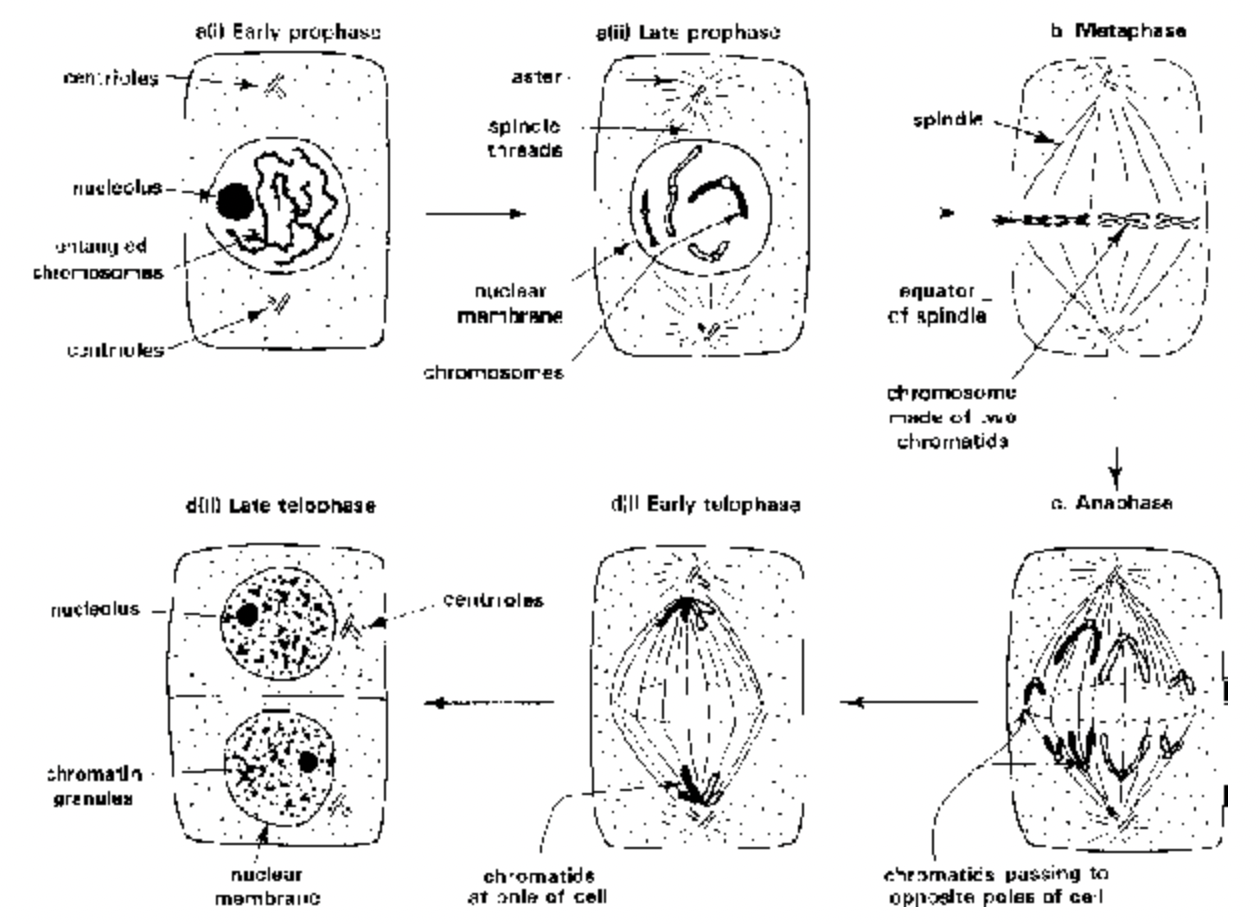M- Phase of cell cycle
Cell cycle of Class 11
Mitosis
Phase of actual cell division (4% of cell cycle).
Mitosis (Gk. mitos = thread) refers to the role of chromosomes at the time of nuclear division.
Occurs in the somatic cells of an organism, brings about growth in multicellular organisms and increase in population of unicellular organisms.
In plants it occurs in stem tip, root tip, intercalary meristem, lateral meristem, for growth of embryo, leaves, flowers, fruits and seeds etc.
In animals it occurs for embryo development and in some restricted regions in the mature form like skin, bone- marrow.
At the time of mitosis there is no change in plant cell structure but animal cell becomes spherical, more viscous and refractile.
It results in the formation of two daughter cells with the same number of chromosomes as in the mother cell.

Fig. Stages of mitotic nuclear division
It includes karyokinesis (indirect nuclear division) and cytokinesis (cytoplasmic division).
The main divisions of this cycle are: prophase, metaphase, anaphase, and telophase. Cytokinesis, is simultaneous with anaphase or telophase, or it can occur at a later stage.
Prophase :
The beginning of prophase is indicated by the apperance of the chromosomes as thin threads inside the nucleus.
Chromosomes start to condense. The condensation occurs by a process of folding of the chromatin fibres.
Each prophase chromosome is composed of two coiled filaments, the chromatids, which are a result of the replication of the DNA during the S phase.
As prophase progresses, the chromatids become shorter and thicker, and the primary constrictions which contain the kinetochores, become clearly visible.
During early prophase, the chromosomes are evenly distributed in the nuclear cavity; as prophase progresses, the chromosomes approach the nuclear envelope, causing the central space of the nucleus to become empty.
In the animal cells the two centrioles of the centrosome separate and move apart, star-like structures with radiating fibres - aster rays are formed around the opposite poles. These are linked by means of thin spindle fibres. The cells of most higher plants also develop spindle but lack centrioles and the asters.
The transition between prophase and metaphase is called prometaphase. This is a short period in which the nuclear envelope disintegrates and the chromosomes are in apparent disorder.
Metaphase
Marked by the appearance of mitotic apparatus, which comprises the spindle and the asters, that surround the centrioles. The spindle is made of the chromosomal fibers, the continuous fibres, and the interzonal fibres.
Fibers of the spindle that connect to the chromosomes are chromosomal fibers; those that extend without interruption from one pole to the other are the continuous fibers. The interzonal fibers are observed at anaphase and telophase between the daughter chromosomes.
After the spindle fibres invade the central area, and their microtubules extend between the poles the chromosomes become attached by the kinetochores to some of the spindle fibres and oscillate until they
become radially oriented in the equatorial plane (congression) and form the equatorial plate.
The kinetochore is the site of implantation of the microtubules in the chromosome. There is usually one kinetochore per chromatid which appears as a cup-like disc 0.20 to 0.25 µm in diameter. Kinetochores contain tubulin, and they act in the assembly of microtubules.
Mitosis in which the spindle has centrioles and asters is called astral or amphiastral and is found in animal cells and some lower plants. Mitosis in which centrioles and asters are absent is called anastral and is found in higher plants, including all angiosperms and most gymnosperms.
Anaphase
At anaphase the equilibrium of forces that characterizes metaphase is broken by the separation of the kinetochores – a process that is carried out simultaneously in all the chromosomes.
The kinetochores move apart, and the chromatids separate and they begin their migration towards the poles. Migration occurs due to contraction of spindle fibres. The force for pull is generated by the tubulin dynein interaction with ATP hydrolysis.
The kinetochore always leads the rest of the chromatid or daughter chromosome, as it is being pulled by the chromosomal fibers of the spindle. The chromosome may assume the shape of a V with equal arms if
it is metacentric or a L with unequal arms if it is submetacentric.
During anaphase the microtubules of the chromosomal fibers of the spindle shorten one-third to one-fifth of the original length. Simultaneously, the microtubules of the continuous fibres increase in length. Some
of these stretched spindle fibers now constitute the so-called interzonal fibers.
Telophase :
The end of the polar migration of the daughter chromosomes marks the beginning of telophase.
The chromosomes start to unfold and become less and less condensed by a process that in some ways recapitulates prophase, but in the reverse direction.
The chromosomes gather into masses of chromatin that become surrounded by discontinuous segments of nuclear envelope made by the endoplasmic reticulum which fuse to make the
two complete nuclear envelops of the daughter nuclei. The nucleoli reappear at the sites of the nucleolar organizers during the final stages.
- Types of Cell Division
- I-Phase/Interphase
- The Regulation of Cell Cycle
- M- Phase of cell cycle
- Cytokinesis / cell cleavage
- Significance of Mitosis
- Abnormal Mitosis of Cell cycle
- Meiosis Of Cell Cycle
- Significance of Meiosis - I
- Differences Between Mitosis and Meiosis
- Types of Meiosis
- some Important Points of Cell Cycle
- Exercise 1
- Exercise 2
- Exercise 3
- Exercise 4
- Exercise 5









